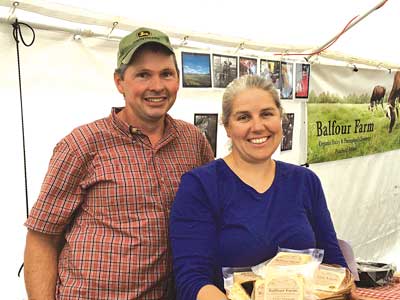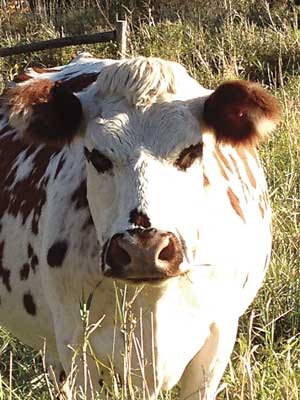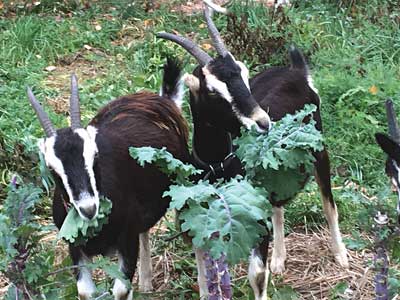 |
| Doug and Heather Donahue of Balfour Farm at their booth at the Common Ground Country Fair. Photo courtesy of Balfour Farm |
By Sonja Heyck-Merlin
In Gaelic, Balfour means “from the grazing or pasture land.” Maine organic farmstead cheesemakers Heather and Doug Donahue settled on the name in honor of Doug’s Irish ancestry. The name also affirms the couple’s two-decade commitment to cultivating a pasture-based dairy.
“In 2000 we were living on a hobby farm in New Hampshire. We bought our first milk cow, a Hereford Holstein cross-breed,” reminisced Heather. “She was the most unlikely milk cow ever, but we had her for 15 years. She gave us a calf every year and was patient with us as we learned how to milk.”
In 2004 Heather and Doug purchased a 200-acre farm in northern New York and took the plunge into full-time farming. Heather left behind a teaching career, and Doug a contracting business. The land they bought had been a dairy farm but hadn’t been farmed in 10 years. They started with four Black Angus, but, Heather explained, “Beef was a slow way to get started farming,” so they traded the Angus head-for-head for a group of Red and White Holsteins and began milking.
By 2006 the Donahues had transitioned the herd to organic and began shipping milk to Horizon. The following year the couple expanded the milking herd to 50 with the purchase of some organic Normandes, and until 2010 they continued shipping wholesale.
“We decided that we wanted to move back to New England in 2009 to be closer to our families,” they explained, “and we were also looking to downsize our milking herd.” By the end of 2010, they had purchased and moved to Balfour, a 100-acre spread in the Somerset County town of Pittsfield.
Only 10 Normandes moved to Maine with them. Although Horizon maintained their contract and continued picking up milk during their first year in Maine, the Donahues realized wholesale production with such a small number of cows was economically unviable.
“We were looking for different ways to [generate more] cash flow, and processing our own milk seemed to be the way to go,” Heather said. “Horizon was very flexible, and we appreciated that we still had a built-in market as we began to establish a direct-market.” In less than a year, they had built a creamery and began selling raw milk, yogurt and soft cheeses at farmers’ markets. “We hit the ground running because we had to,” added Heather.
 |
| Tansy, a Normande cow. Photo courtesy of Balfour Farm |
In typical New England fashion, the Pittsfield property included a big house, little house, backhouse and barn – all situated close to a busy secondary road. The 40 acres of open land north of the original farmstead is the heart of the farm’s rotational grazing system.
When their two daughters moved out of the house, the Donahues realized it was their opportunity to downsize their living space and build a more efficient barn and creamery away from the road. They chose a partially wooded site accessed by a new half-mile driveway that bisects their pasture ground. In 2015 they began construction on an 84- x 24-foot structure.
The new facility is powered primarily by a 45 kilowatt diesel generator, and the farm also generates a small amount of solar power. Heather said, “In general, the generator runs from four to 11 hours per day – a longer day for making yogurt due to the incubation time, a shorter day for just chores without any processing. Hooking to the grid might have been an option if it wasn’t so expensive, but we didn’t want to look at power lines either.”
The structure includes a 12-cow tie-stall with a pipeline milking system, a milk house and storage area, creamery and walk-in cooler. When the ground froze, they skidded their old farm store across the pasture and transformed it into a temporary cabin. They now look south toward the old farmstead and their pasture ground.
The farm business has evolved alongside the infrastructure. At first the Donahues focused on direct-marketing fluid milk, fresh cheeses and yogurt, but that product mix did not provide adequate cash flow. Heather said, “The price difference between a gallon of wholesale milk and direct-marketed milk was significant but it wasn’t enough. We knew we had to make other products that were higher value.”
They maintained the yogurt and fresh cheese part of the business but decided to turn their fluid milk business into a raw hard cheese one. Cheese vats can be prohibitively expensive, but with family ingenuity (Doug’s brother is a plumber), the Donahues were able to transform a 300-gallon bulk tank into a cheese vat. The compressor was removed and the bulk tank was plumbed directly into an oil-fired water heater.
They went into hard cheese “because it’s a higher value item, is shelf-stable and gets better with age,” said Heather, adding that “milk is extremely perishable unless you turn it into something else.” In 2016 Balfour produced 3,942 pounds of cheddar, gouda and pyrenees-style hard cheese. A small herd of Alpine goats is being transitioned to organic to diversify their cheese offerings.
A 35-gallon pasteurizer is the other fundamental piece of equipment in the creamery. Milk for the fresh cheeses, buttermilk, cultured cream and yogurt is heated in the jacketed pasteurizer, cooled and then cultured. Products are incubated in a homemade 4- x 4-foot closet heated by electric baseboard heat.
While wholesale organic milk prices in Maine are hovering in the high $30s per hundred pounds of milk (cwt.), the Donahues are grossing about $200/cwt. “It sounds like a lot,” Heather said about the high value of their milk, “but the flip side is that we have a lot of additional costs because we not only process our milk but also self-distribute and do all of our own marketing.”
 |
| Goats clean up the fall garden. Photo courtesy of Balfour Farm |
Although their farming career has been punctuated by moving to Maine, building barns, changing markets and changing products, one thing that has remained steady is the Donahues’ duty and commitment to their cows. This is reflected in the herd’s milk quality (somatic cell count running in the 60,000 to 85,000 range), body condition and longevity.
The most significant change they have made in their cow management was the shift in the spring of 2012 to once-a-day (OAD) milking. “We found it nearly impossible to process milk, attend farmers’ markets and then get evening milking done,” they said about the impetus to go to OAD. “We were faced with losing our evening milker, and we just decided not to hire anyone else.”
Their herd has adapted to OAD well. Annual production per cow is 9,000 pounds, with butterfat at 4.8 percent and protein at 3.6 percent. By eliminating the demand of twice-a-day milking on the cows, they find that the animals breed back quicker and don’t lose body condition during the winter.
“We don’t have a lot of turnover in our herd,” they explained. “Our oldest cow is 15 years old, and she is still one of our most productive. We go for longevity rather than constantly turning over new animals. We only need to raise two calves every other year.”
Heather said, “We have raised calves just about every way you can.” They started with bottles but found that the number of bottles necessary on a 50-cow dairy was overwhelming. Bottles were exchanged for buckets, but they found that bucket-raised calves weren’t as thrifty. At some point they attended a conference and learned about farms that were raising calves on brood cows.
“Brood cows worked great and saved labor. It produces the best calves you’re ever going to raise,” Heather said. “The tricky part is getting them weaned. We still have a 3-year-old heifer that keeps trying to suckle her mother. We had to put a ring in her nose. It’s also difficult to catch them at weaning time. They also tend to be standoffish and less friendly than a bottle calf.”
Because of these challenges, the Donahues have returned to bottle feeding. One gallon of whole milk is fed twice a day for three months. (Milk replacer is not allowed in organic production.) A few weeks before weaning, free-choice dry hay and grain are offered. The milk ration is ratcheted down and diluted with water for a few weeks as the calf learns to drink water from a bucket.
From mid-May to September the cows are grazed rotationally on 3/4-acre paddocks. The cows are turned out to a new paddock every 24 hours after morning milking. During the non-grazing season, the cows are turned onto a 10-acre sacrifice paddock and fed balage from round bale feeders. Year-round each cow also receives 4 pounds of 16 percent protein pelletized organic grain.
The Donahues rent an additional 70 acres of hay ground from neighboring landowners. They run their disc mower and rake with an International 656. In 2016 the couple produced 260 round bales, two-thirds balage and one-third dry hay. Both types of hay are wrapped with individual Vermeer bale wrappers.
In 2016 the Donahues planted 1 acre of turnips to be fed as a supplement to their winter forage program. They also picked up 1 acre of organic beets from a nearby veggie grower. Doug said, “We’re trying to grow more of our own feed on the home farm. Feed is our second highest cost behind fuel. If we can reduce feed costs, it would put our bottom line in a better position.”
The beets and turnips are run through a homeowner’s model shredder/chipper and fed at a rate of 10 to 12 pounds per cow per day. The veggie mash is mixed with the grain ration and fed during milking time. Forage-based dairies struggle to find energy to balance the high protein in pasture and balage, and the Donahues hope the beets and turnips will fill this need.
From this careful attention to the cows and their forage come the rich milk and other dairy products for which the Normande breed is prized. Attending farmers’ markets ranging from Orono to Portland and supplying nine wholesale outlets, the Donahues log a significant amount of time on the road. Once the cheese has been cut and wrapped, the yogurt incubated and the fresh cheese flavored and packed, it is ultimately up to the consumer to support Maine’s dairies.
Heather reflected, “I think of all the cheesemakers I know, and we would all like to sell more. Consumers need more education about Maine cheese, and also need to know they can get their dairy products locally. The market is growing, but I don’t think consumer demand has caught up with the supply. When people think of Vermont, they think cheese. I want Maine to have the same reputation.”
About the author: Sonja Heyck-Merlin and her partner Steve Morrison raise cows, gardens, grass and kids on Clovercrest Farm in Charleston, Maine. Clovercrest Farm, a second-generation dairy farm, milks 90 Jerseys and has been MOFGA-certified organic since 1995.
